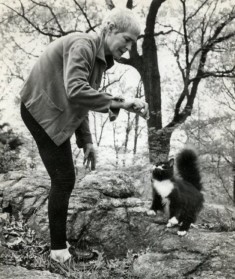| Margaret Bourke-White | |
|---|---|
 |
|
| Photographer | |
| Born | June 14, 1904 The Bronx, New York |
| Died | Aug. 27, 1971 (at age 67) Stamford, Connecticut |
| Nationality | American |
Margaret Bourke-White was an American photographer who helped pioneer war photography, becoming the first female photographer to work on the front lines. She was also the first non-Soviet citizen to be allowed to take pictures of industrial areas in the USSR.
Bourke-White took the photograph for the first edition of Life magazine. In later life, she developed Parkinson’s disease, the condition which eventually killed her. Bourke-White’s left-wing political opinions occasionally caused her problems, particularly during the “Red Scares” of the 1950s.
Early Life
Bourke-White was born on June 14, 1904, in New York City. She was interested in photography from an early age, encouraged by her father, but eventually enrolled at Cornell University to study herpetology. Her photographic interest did not desert her, however, and she ended up transferring from college to college.
In 1927, she received a B.A. degree from Columbia University, where she had been taught photographic methods by Clarence White. After her graduation, she went to Cleveland, Ohio, and set up a studio dedicated to the photography of architecture. Her life was shortly to change for good, however: in 1929, Henry Luce signed her up to the staff of his magazine, Fortune.
A Photography Career Begins
While working for Fortune, Bourke-White was granted unprecedented access to Soviet industrial zones, and by 1931 she collected some of her material in a book, Eyes on Russia. A combination of her Russian experiences and the Great Depression at home led her to become more and more active in left-wing politics.
In 1937, she and Erskine Caldwell caused controversy with their book, You Have Seen Their Faces. This strongly attacked racism, especially in the Deep South, and upset many conservative whites. Meanwhile, she had moved from Fortune to the new Life magazine, taking the photograph of Fort Peck Dam that featured on its debut cover.
Activism and Investigation
 Bourke-White became a member of the American Artists Congress, like many other leftist artists including Rockwell Kent and Stuart Davis. The group’s platform included anti-fascism, the ending of racial discrimination, and public funding for arts programs.
Bourke-White became a member of the American Artists Congress, like many other leftist artists including Rockwell Kent and Stuart Davis. The group’s platform included anti-fascism, the ending of racial discrimination, and public funding for arts programs.
Although never actually a member of the Communist Party, she did join several organizations which were little more than fronts, such as the American Youth Congress. In 1939, she married Caldwell, and they were in the USSR at the time of the 1941 German invasion, the only Western journalists to be present. During the war, Bourke-White worked as a war correspondent, accompanying American troops at the liberation of Buchenwald, but also continued to attack social inequality in the United States.
Post-War Activities
Once the war was over, Bourke-White spent time covering the advent of South African apartheid, as well as the campaigning of Gandhi in India. However, the FBI had been passing information on her political work to Senator Joe McCarthy’s House Un-American Affairs Committee. She managed to avoid being called in front of it by stating a firm opposition to dictatorial regimes, whichever side of the political spectrum they fell on.
Later Years and Death
She continued to work during the Korean War, taking a famous picture of a mother greeting the son she thought had died in the fighting. Bourke-White was diagnosed with Parkinson’s disease in 1952 and was forced to retire from photography. She died in Connecticut on August 27, 1971.